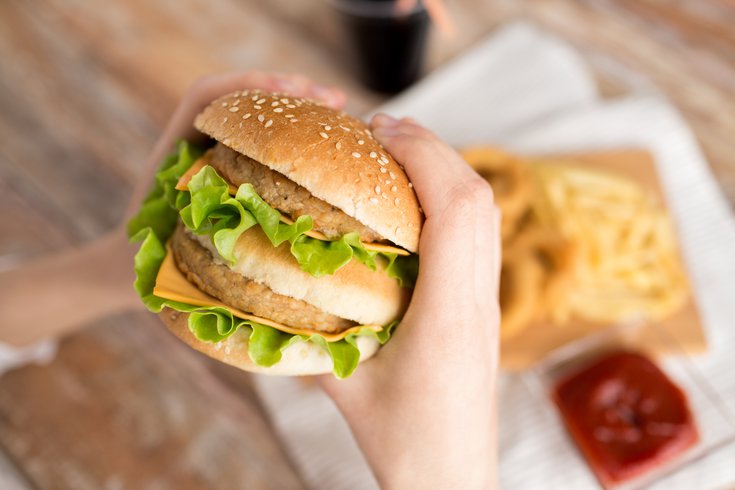
January 13, 2023
 Source/Image licensed from Ingram Image
Source/Image licensed from Ingram Image
People with obesity or diabetes who get 20% of their daily calories from fast food have extremely high levels of liver fat, a new study finds.
The prevalence of nonalcoholic fatty liver disease has risen sharply, prompting doctors to emphasize the importance of eating healthy to prevent liver damage.
Nonalcoholic fatty liver disease, or NAFLD, is a liver disease that is caused by factors other than excessive alcohol use. A fatty liver simply means that more than 10% of the liver's weight is fat. The condition can prompt the liver to swell, causing scarring, and may lead to cancer or organ failure.
Though its exact cause is unknown, research has linked NAFLD to metabolic factors such as high cholesterol, obesity and diabetes. Up to 75% of people who have obesity or diabetes, and up to 90% of people with class III obesity – the most severe form – develop NAFLD.
About 100 million U.S. residents have Nonalcoholic Fatty Liver Disease, according to the Liver Foundation. It is the most common form of liver disease in children and its prevalence has doubled in the past 20 years.
Certain diets, especially those high in sugar and fat, and genetics make some people more prone to NAFLD. And fast food, in particular, has been shown to be harmful to the liver.
Overconsumption of fast food is one of the biggest concerns when it comes to diet, according to research.
A study published Tuesday found that people with obesity or diabetes, who consumed at least 20% of their daily calories from fast food, had extremely high levels of fat in their livers compared to people who ate less fast food.
Even people without obesity or diabetes experienced moderate increases in liver fat when fast food made up one-fifth or more of their diets, the research showed.
"Healthy livers contain a small amount of fat, usually less than 5%, and even a moderate increase in fat can lead to nonalcoholic fatty liver disease," said researcher Dr. Ani Kardashian, a hepatologist with University of Southern California. "The severe rise in liver fat in those with obesity or diabetes is especially striking, and probably due to the fact that these conditions cause a greater susceptibility for fat to build up in the liver."
Kardashian warned that even a modest amount of fast food can be harmful to the liver.
"If people eat one meal a day at a fast-food restaurant, they may think they aren't doing harm," she said. "However, if that one meal equals at least one-fifth of their daily calories, they are putting their livers at risk."
For the study, researchers used data on 4,000 adults from a nationwide health and nutrition survey conducted in 2017 and 2018 to determine the impact of fast food consumption on fatty liver disease.
A Swedish study previously produced similar findings. For this project, healthy volunteers were asked to eat fast food at least twice a day and reduce their physical activity levels to less than 5,000 daily steps.
Within four weeks, the volunteers had gained an average of 14 pounds, with one participant gaining as much as 26.5 pounds. Blood samples showed that the levels of certain liver enzymes that indicate liver damage had increased in just one week. By the end of the month, those levels were four times higher than they were at the start of the experiment. Some volunteers' enzymes levels got so high that they indicated liver damage; one even developed symptoms of fatty liver disease.
A 2021 study of college students in Jordan found different results. Fast food consumption could not be directly linked to increased levels of liver enzymes, but eating fast food and drinking soda was associated with increasing body weight – behaviors known to have long-term, adverse effects on the liver.
Nonalcoholic fatty liver disease doesn't always cause symptoms; some people can live with it for the rest of their lives without complications.
For about 2% to 5% of people with this disease, the fat deposits lead to inflammation and cell damage in the liver. This condition is known as nonalcoholic steatohepatitis, or NASH.
NASH causes pain and swelling in the upper right abdomen, where the liver is located. Some people don't experience noticeable symptoms until the liver damage has become severe, leading to cirrhosis. Though medications can help slow down the progression of cirrhosis, when the liver can no longer function properly, a liver transplant may become necessary. Fatty liver disease also increases the risk of liver cancer.
Researchers say that fast food-related liver damage can be reversed. One of the major cornerstones of treatment and prevention of NAFLD is healthy diet and exercise, including the elimination of fast food. Health care providers recommend that patients lose about 3% to 5% of their body weight. They are advised to do it gradually, dropping no more than 1 to 2 pounds per week.
Intermittent fasting has been found to be an effective way to reverse liver damage quickly. Intermittent fasting is defined by alternating set periods of fasting with periods in which eating is permitted. Though this practice has been associated with multiple health benefits, there is still a lack of long-term data on it.
To prevent the fat deposits, doctors advise people to properly manage their weight, cholesterol, blood pressure and blood sugars bye eating a healthy diet and using medications, if necessary. The Mediterranean diet is often recommended for people with fatty liver disease because it replaces sweets and processed foods with fruits, vegetables and whole grains.